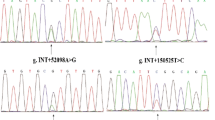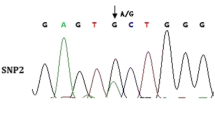Abstract
Body measurement and meat quality traits which play important roles in the assessment of productivity and economy in cattle were influenced by genes and environmental factors. Latest studies showed that LYR motif containing 1 (LYRM1) may be involved in influencing fatness deposition in animals. The objective of this study was to detect bovine LYRM1 gene polymorphism and analyze its association with body measurement and meat quality traits of cattle. Blood samples were taken from a total of 404 Qinchuan cattle aged from 18–24 months. Created restriction site-polymerase chain reaction-restriction fragment length polymorphism (CRS-PCR–RFLP) and DNA sequencing were used to find out LYRM1 single polymorphism nucleotide (SNPs). Sequence analysis of LYRM1 gene revealed two SNPs (g.165 C > A, g.193 A > G) in 3′ untranslated region (3′UTR) of exon 3. And g.165 C > A showed two genotypes namely AC and CC while g.193 A > G showed three genotypes: AA, AG and GG. Analysis results showed that there were significant associations between polymorphism of these two and body measurement and meat quality traits in Qinchuan cattle population. Based on the results obtained from this study, it is inferred that LYRM1 gene may have potential effects on body measurement and meat quality traits in Qinchuan cattle population and could be used for marker-assisted selection.


Similar content being viewed by others
References
Jeffery RW, Sherwood NE (2008) Is the obesity exaggerated? No. BMJ 336:244–246
Lee YS (2009) The role of genes in the current obesity epidemic. Ann Acad Med Singap 38:45–47
Walley AJ, Asher JE, Froguel P (2009) The genetic contribution to non-syndromic human obesity. Nat Rev Genet 10:431–442
Mokdad A, Ford E, Bowman B et al (2003) Prevalence of obesity, diabetes, and obesity-related health risk factors. JAMA 289:76–79
Cao XG, Kou CZ, Zhao YP et al (2010) Overexpression of LYRM1 induces mitochondrial impairment in 3T3-L1 adipocytes. Mol Genet Metab 101(4):395–399
Qiu J, Gao CL, Zhang M et al (2009) LYRM1, a novel gene promotes proliferation and inhibits apoptosis of preadipocytes. Eur J Endocrinol 160:177–184
Kou CZ, Cao XG, Qin DN et al (2011) Over-expression of LYRM1 inhibits glucose transport in rat skeletal muscles via attenuated phosphorylation of PI3K (p85) and Akt. Mol Cell Biochem 348:149–154
Nkrumah JD, Li C, Basarab JB et al (2003) Association of a single nucleotide polymorphism in the bovine leptin gene with feed intake, feed efficiency, growth, feeding behaviour, carcass quality and body composition. Can J Anim Sci 84:211–219
Weedon MN, Lettre G, Freathy RM, Lindgren CM et al (2007) A common variant of HMGA2 is associated with adult and childhood height in the general population. Nat Genet 39(10):1245–1250
Gilbert RP, Bailey DRC, Shannon NH (1993) Linear body measurements of cattle before and after 20 years of selection for postweaning gain when fed two different diets. J Anim Sci 71:1712–1720
Hamlin KE, Green RD, Cundiff LV (1995) Real-time ultrasonic measurement of fat thickness and longissimus muscle area: II. Relationship between real-time ultrasound measures and carcass retail yield. J Anim Sci 73:1725–1734
Brethour JR (1994) Estimating marbling score in live cattle from ultrasound images using pattern recognition and neural network procedures. J Anim Sci 72:1425–1432
Mullenbach R, Lagoda PJ, Welter C (1989) An efficient salt-chloroform extraction of DNA from blood and tissues. Trends Genet 5(12):391
Nei M, Roychoudhury AK (1974) Sampling variance of heterozygosity and genetic distance. Genetics 76:379–390
Nei M, Li WH (1979) Mathematic model for studying genetic variation in terms of restriction endonucleases. Proc Natl Acad Sci USA 76(10):5269–5273
(2002) Fact sheets from the surgeon general’s call to action to prevent and decrease overweight and obesity. W V Med J 98(6):234–43
Zhang M, Zhao HM, Qin ZY et al (2012) Regulation of LYRM1 gene expression by free fatty acids, adipokines, and rosiglitazone in 3T3-L1 adipocytes. Exp Diabetes Res 2012:820989
Adoligbe C, Zan LS, Farougou S et al (2012) Bovine GDF10 gene polymorphism analysis and its association with body measurement traits in Chinese indigenous cattle. Mol Biol Rep 39:4067–4075
Rothschild MF, Soller M (1997) Candidate gene analysis to detect genes controlling traits of economic importance in domestic livestock. Probe Newsl Agric Genomic 8:13–20
Li F, Chen H, Lei CZ, Ren G et al (2010) Novel SNPs of the bovine GAD1/gad67 gene and their association with growth traits in three native Chinese cattle breeds. Mol Biol Rep 37:501–505
Chu MX, Zhao XH, Zhang YJ, Jin M et al (2010) Polymorphisms of BMPR-IB gene and their relationship with litter size in goats. Mol Biol Rep 37(8):4033–4039
Schulz RA, Yutzey KE (2004) Calcineurin signaling and NFAT activation in cardiovascular and skeletal muscle development. Dev Biol 266:1–16
Jiao Y, Zan LS, Liu YF, Wang HB et al (2010) A novel polymorphism of the MYPN gene and its association with meat quality traits in Bos taurus. Genet Mol Res 9:1751–1758
Qiu J, Ni Y, Gong H et al (2007) Identification of differentially expressed genes in omental adipose tissues of obese patients by suppression subtractive hybridization. Biochem Biophys Res Commun 352(2):469–478
Qin ZY, Zhang M, Guo XR, Wang YM et al (2012) α-Lipoic acid ameliorates impaired glucose uptake in LYRM1 overexpressing 3T3-L1 adipocytes through the IRS-1/Akt signaling pathway. J Bioenerg Biomembr 44(5):4033–4039
Acknowledgments
We thank all the research assistants and laboratory technicians who contributed to this study. We extend special thanks to Professor Zan and Dr. Cheng for their assistance. This work was supported by Program for Changjiang Scholars and Innovative Research Team (IRT0940), beneficial beef cattle and cellular engineer breeding technology research (2011AA100307-02), selecting and breeding new high quality beef cattle and its key technologies (2011BAD28B04-03), GMO new varieties major project (2011ZX08007-002), Beef cattle and Yak Industrial Technology System Project (CARS-38).
Author information
Authors and Affiliations
Corresponding author
Rights and permissions
About this article
Cite this article
Li, Y., Gao, J., Yang, N. et al. The polymorphisms of LYRM1 gene and their association with body measurement and ultrasound traits of Qinchuan cattle. Mol Biol Rep 40, 1511–1517 (2013). https://doi.org/10.1007/s11033-012-2195-6
Received:
Accepted:
Published:
Issue Date:
DOI: https://doi.org/10.1007/s11033-012-2195-6




